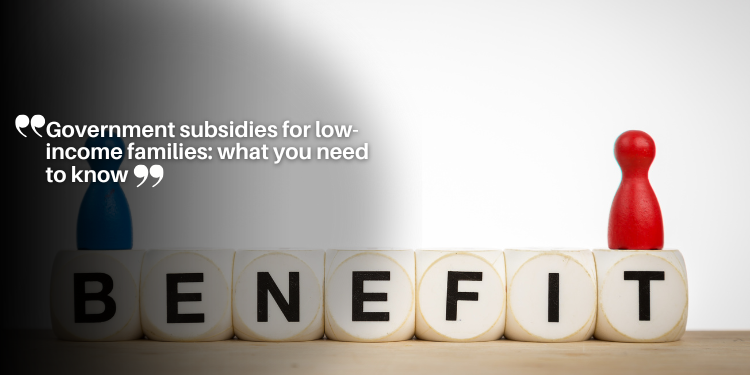Government subsidies for low-income families: what you need to know

Government subsidies for low-income families provide essential financial support for housing, food, and healthcare, ensuring that eligible households can improve their quality of life and meet basic needs.
Government subsidies for low-income families play a vital role in supporting households struggling to make ends meet. Have you ever wondered how these programs could impact your family? Let’s dive into the options available.
Understanding government subsidies
Understanding government subsidies can feel overwhelming, but these programs are designed to help families make ends meet. At their core, subsidies provide financial aid to those who need it most. They come in various forms, each tailored to address different challenges faced by low-income households.
What Are Government Subsidies?
These are payments made by the government to assist individuals or groups with certain costs. They aim to reduce financial burdens and improve the quality of life. Government subsidies can help families in several essential areas, including housing, food, education, and healthcare.
Types of Government Subsidies
- Housing Assistance: Programs like Section 8 vouchers help cover rent costs.
- Food Support: SNAP (Supplemental Nutrition Assistance Program) provides assistance for purchasing food.
- Childcare Assistance: Financial aid is available to help pay for childcare expenses.
- Healthcare Aid: Medicaid offers health coverage for eligible low-income families.
By accessing these resources, families can manage their expenses better. Understanding the availability and application process for subsidies is key to utilizing them effectively. Many people might not realize that assistance is out there, waiting to be tapped into.
To further navigate the complex world of government subsidies, it is essential to be aware of eligibility criteria. Each program has specific requirements that applicants must meet. This can include income limits, family size, and residency status.
How to Access These Programs
Finding the right program can be as simple as visiting local government websites or community organizations. Many offer assistance with applications, making the process smoother. When applying, gather necessary documents like income statements or proof of residency. Being prepared helps prevent delays and ensures a better chance of approval.
In summary, government subsidies can be a vital lifeline for low-income families. By understanding what is available and how to apply, families can significantly improve their financial situations.
Types of subsidies available
When looking for support, it’s important to understand the different types of subsidies available to low-income families. Each subsidy serves a unique purpose, offering assistance in various areas of life. Families can access a range of programs to meet their specific needs.
Housing Subsidies
Housing subsidies are designed to make housing more affordable for low-income families. Programs like Section 8 provide vouchers that cover a portion of rent. This helps families find safe and stable places to live.
Nutrition Assistance
Nutrition is vital for family health, and food support programs like SNAP (Supplemental Nutrition Assistance Program) ensure that families can buy groceries. These funds can significantly ease the burden of food costs.
Childcare Assistance
Childcare can be a substantial expense for working families. Grants and subsidies are available to help cover these costs, allowing parents to work while ensuring their children are cared for. This support can include direct payments or reimbursement for childcare services.
Healthcare Programs
Access to healthcare is crucial, and Medicaid provides healthcare coverage for eligible low-income families. This ensures that children and adults receive necessary medical care without the financial strain.
- Transportation Subsidies: Some programs help cover transportation costs for work-related travel.
- Utility Assistance: Subsidies are available to help pay for essential utilities like electricity and water.
- Education Grants: Families can also receive funds to help cover education costs for children and adults.
In summary, knowing the various types of subsidies available allows families to make informed decisions that can enhance their quality of life. By accessing the right resources, families can alleviate financial stress and focus on building a better future.

Eligibility for low-income families
Determining eligibility for low-income families to receive government subsidies is a crucial step in accessing financial support. Each program has unique criteria, making it essential for families to understand what qualifications they need to meet.
Income Limits
One of the main factors is income. Families must fall below a specific income threshold to qualify. This limit often varies based on household size, location, and the type of assistance sought.
Family Size
Alongside income, the size of the family plays a significant role in eligibility. A family of four will have a different income limit compared to a single parent. Understanding these distinctions can help families better assess their situations.
Residency Requirements
Most programs require applicants to be legal residents of the area where they seek assistance. Proof of residency may be needed, such as a utility bill or lease agreement.
- Application Process: Families must complete an application, providing detailed information about finances and family structure.
- Documentation: Important documents, like pay stubs or tax returns, will need to be submitted to prove eligibility.
- Assessment Period: Some programs have deadlines for applications, so it’s crucial to act quickly.
By understanding eligibility criteria, families can more effectively navigate these programs. Gathering necessary paperwork in advance can simplify the process and increase the chances of receiving assistance.
Becoming aware of local resources that offer guidance on eligibility can help families avoid common pitfalls. Community organizations often provide valuable information and support to help families through the application process.
How to apply for these subsidies
Applying for government subsidies can seem daunting, but understanding the process can help families navigate it more easily. Each program has specific steps, but some general guidelines apply to most.
Research Available Programs
Start by researching the different types of subsidies available to low-income families. Knowing what assistance you qualify for is the first step. Local government websites often provide a list of available programs along with eligibility criteria.
Gather Necessary Documents
Before applying, collect all required documents, such as proof of income, identification, and residency documentation. Commonly needed documents include:
- Pay stubs or proof of income.
- Tax returns for the previous year.
- Utility bills to verify residency.
- Social Security cards for all family members.
Having these documents ready will speed up the application process and reduce the likelihood of missing information.
Complete the Application
Fill out the application form accurately, providing all requested information. Be thorough and honest in your responses. Many programs offer online applications, making it easier to submit your information without having to visit an office.
Follow Up
After submitting your application, keep track of its status. Many programs allow you to check your application status online. If required, be prepared to provide additional information or attend an interview. Staying proactive will help ensure your application is processed smoothly.
Community organizations can also assist with the application process, offering guidance and support. They may have staff available to review applications before submission, helping to prevent mistakes that could delay approval.
By understanding how to apply for these subsidies, families can access the resources they need to improve their quality of life. Being informed and prepared can make a significant difference in the outcome of your application.
Understanding government subsidies for low-income families is crucial in improving financial stability. By knowing the types of assistance available, the eligibility requirements, and how to apply, families can access vital resources. Participation in these programs can play a significant role in reducing stress and enhancing overall well-being. It’s important for families to research options, gather necessary paperwork, and follow the application steps to ensure they receive the help they need. Community resources can also provide support during this process, making it easier for families to take advantage of available aid.
FAQ – Frequently Asked Questions about Government Subsidies for Low-Income Families
What are government subsidies for low-income families?
Government subsidies are financial assistance programs designed to help low-income families afford basic needs such as housing, food, and healthcare.
How do I know if I am eligible for these subsidies?
Eligibility often depends on factors such as income level, family size, and residency status. Review specific program criteria for detailed information.
What documents do I need to apply for subsidies?
Common documents include proof of income, identification, residency documentation, and sometimes tax returns. Having these ready can streamline your application.
Where can I find assistance to apply for subsidies?
Local community organizations and government offices often provide support in the application process, offering guidance and necessary resources to help families navigate the system.







